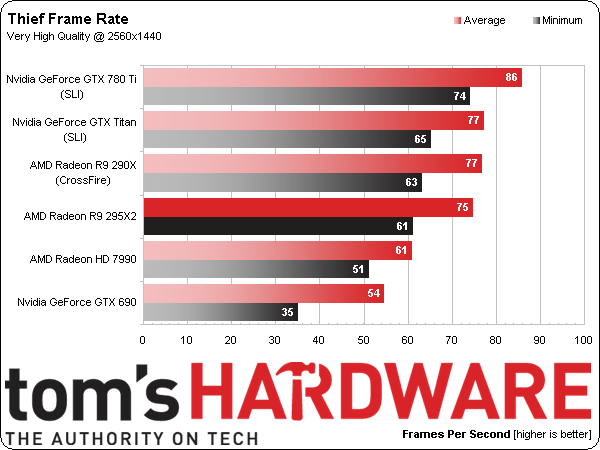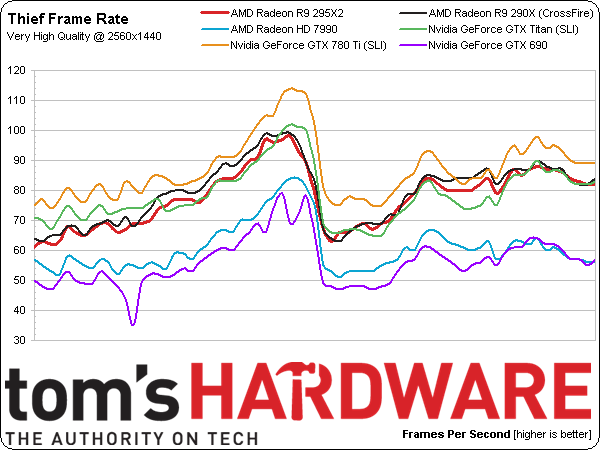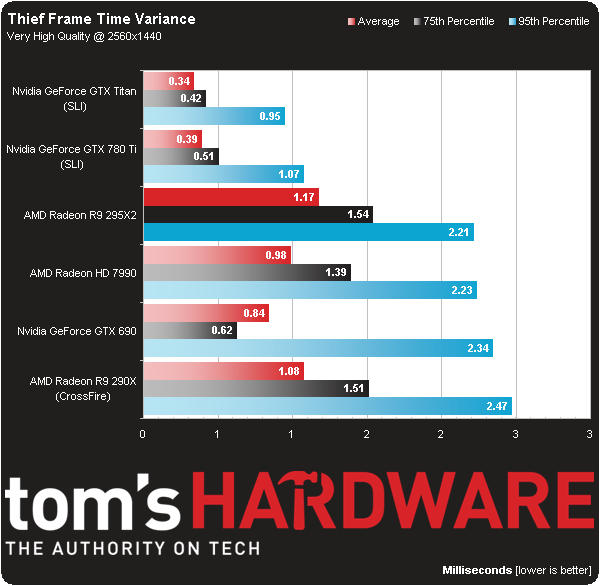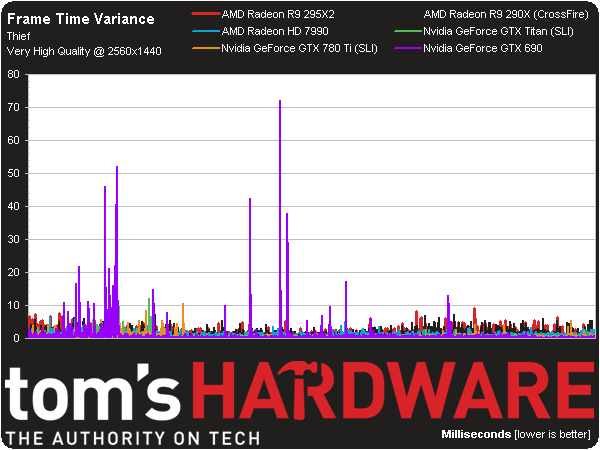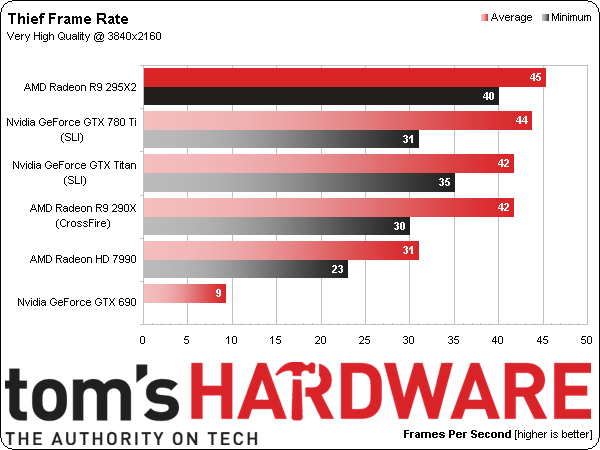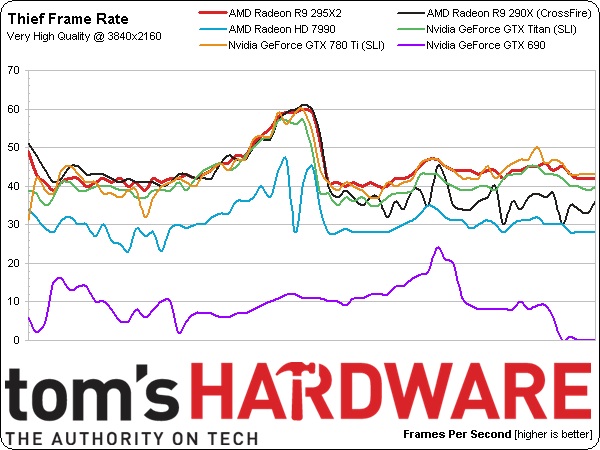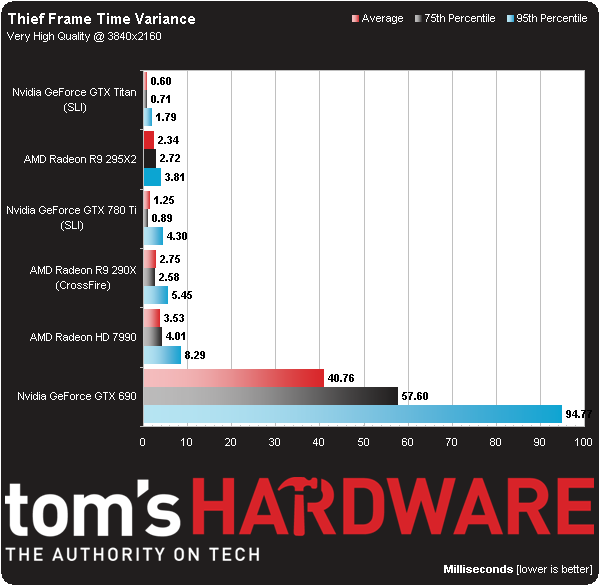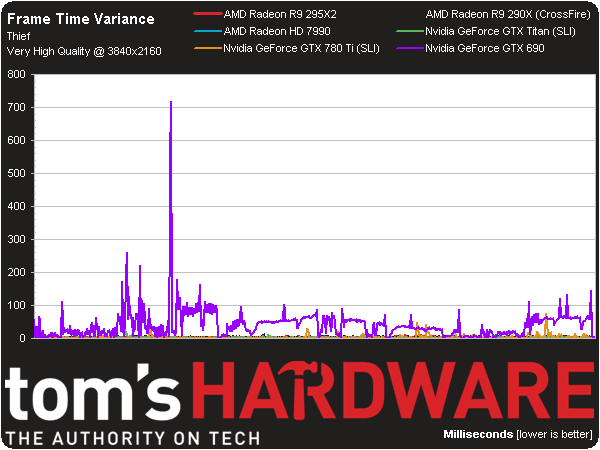Radeon R9 295X2 8 GB Review: Project Hydra Gets Liquid Cooling
“Do you have what it takes?” AMD asks, purportedly referring to the big budget and beefy power supply you need before buying its new Radeon R9 295X2. We benchmark the 500 W, dual-GPU beast against several other high-end configs before declaring a winner.
Results: Thief
2560x1440
AMD’s Radeon R9 290Xes in CrossFire and R9 295X2 perform similarly in Thief. But solid frame rates don’t stop Nvidia’s GeForce GTX 780 Tis and Titans in SLI from scoring first- and second-place finishes.
Meanwhile, the Radeon HD 7990 and GeForce GTX 690 trail. We’ve seen Thief eat up a ton of graphics memory, so it’s possible that the 690’s 2 GB of GDDR5 per GPU is responsible for the low minimum frame rate figure.
Aside from one hitch encountered by Nvidia’s GeForce GTX 690, all of these results are both smooth and playable.
Every tested configuration exhibits low frame time variance. There is one result more notable than the others, though. Typically, we’d expect average variance lower than the 75th percentile, which in turn should be lower than the 95th percentile. But the GeForce GTX 690’s 75th percentile figure is higher than the average.
A look at the frame time chart shows why. In essence, the 690 is plagued by a handful of severe snags. So, while it’s typically a strong performer, those spikes drive up the average and 95th percentile results.
3840x2160
AMD’s Radeon R9 295X2 continues its chart-topping march in Thief, averaging 45 FPS, but more impressively keeping minimum performance above 40 FPS.
As you can see from the GeForce GTX 690’s showing, graphics memory is an important consideration at this title’s Very High preset. We can’t even blame multi- or super-sampled anti-aliasing; the quality setting employs FXAA. Three gigabytes per GPU might not even be enough. Although Nvidia’s GeForce GTX 780 Ti takes second place in the averages, it dips back to a minimum of 31 FPS. Two Titans hold up a little better.
Get Tom's Hardware's best news and in-depth reviews, straight to your inbox.
Fortunately, it looks like the 780 Tis only get hit hard in a couple of places. Otherwise, they hang right there with AMD’s cards.
All of the frame time variance figures are acceptable, aside from the GeForce GTX 690.
Huge variance numbers from a couple of GK104 GPUs throw off the scale of this chart.
-
Marsian Gustrianda Many people doubt about Dual GPU Hawaii will be Blow Up. It seems AMD really do well job. Nice Looking CardReply -
ohim This card is like the Veyron of WV , show the world what you can do (R295x2) but you`ll still relay on the sales of your WV Golf for revenue (270x, 280x)Reply -
outlw6669 Impressive performance, temperatures and fairly low noise!Reply
I would prefer a bit lower price, but this looks like a great card for the gamer that has everything! -
gunfighter zeck the name Dreadnaught originated from Dread Nothing or, fear nothing.Reply
Boss ship. -
Maxamus456 Hope this price stays low and not get bloated from bit con miners like its predecessors.Reply -
blubbey So let me get this straight. It runs pretty cool, quiet, performs well and (for the moment) is able to play a good selection of games at 4k admirably and is priced competitively. Plus if you are going to drop a bit more on watercooling your GPUs (which is a possibility if you're spending $1200+) that gives this card even greater value. Nice work AMD.Reply -
marciocattini Wheres Tom's Hardware seal of approval? =( clearly this card diserves some love!Reply
